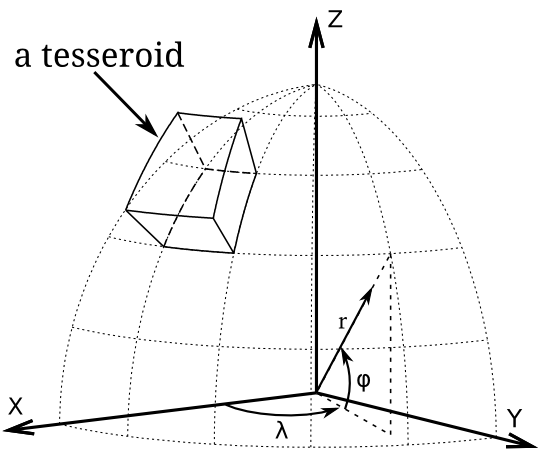https://github.com/leouieda/tesseroids
Forward modeling of gravity fields in spherical coordinates
https://github.com/leouieda/tesseroids
c earth-science geophysics gravity
Last synced: 14 days ago
JSON representation
Forward modeling of gravity fields in spherical coordinates
- Host: GitHub
- URL: https://github.com/leouieda/tesseroids
- Owner: leouieda
- License: bsd-3-clause
- Created: 2013-01-30T15:43:39.000Z (over 12 years ago)
- Default Branch: master
- Last Pushed: 2017-05-24T21:30:53.000Z (over 8 years ago)
- Last Synced: 2025-09-05T21:08:58.355Z (about 1 month ago)
- Topics: c, earth-science, geophysics, gravity
- Language: C
- Homepage: http://tesseroids.leouieda.com
- Size: 16.1 MB
- Stars: 33
- Watchers: 6
- Forks: 12
- Open Issues: 9
-
Metadata Files:
- Readme: README.md
- License: LICENSE.txt
- Citation: CITATION.txt
Awesome Lists containing this project
README
# 
[Documentation](http://tesseroids.leouieda.com) |
[Download](https://github.com/leouieda/tesseroids/releases)
[](https://github.com/leouieda/tesseroids/releases)
[](https://travis-ci.org/leouieda/tesseroids)
[](https://github.com/leouieda/tesseroids/blob/master/LICENSE.txt)
[](http://dx.doi.org/10.5281/zenodo.582366)
*Forward modeling of gravitational fields in spherical coordinates.*
Developed by [Leonardo Uieda](http://www.leouieda.com)
in cooperation with [Carla Braitenberg](http://lithoflex.org/).
## About
*Tesseroids* is a collection of **command-line tools**
for modeling the gravitational potential, acceleration, and
gradient (Marussi) tensor.
The mass models can be made of right rectangular prisms or tesseroids
(spherical prisms).
Computation for rectangular prisms can be made in Cartesian or spherical
(geocentric) coordinates.
[](http://tesseroids.leouieda.com/en/latest/theory.html#what-is-a-tesseroid-anyway)
## License
*Tesseroids* is [free software](http://www.fsf.org/about/what-is-free-software)
made available under the terms of the
BSD 3-clause license.
See [LICENSE.txt](https://github.com/leouieda/tesseroids/blob/master/LICENSE.txt).
## Citing
*Tesseroids* is research software made by scientists.
If you use it in your research,
please **cite** our *Geophysics* paper in your publications:
> Uieda, L., V. Barbosa, and C. Braitenberg (2016), Tesseroids: Forward-modeling gravitational fields in spherical coordinates, GEOPHYSICS, F41-F48, doi:[10.1190/geo2015-0204.1](http://dx.doi.org/10.1190/geo2015-0204.1).
You can download a copy of the paper PDF at
[leouieda.com/papers/paper-tesseroids-2016.html](http://www.leouieda.com/papers/paper-tesseroids-2016.html)
and see all source code used in the paper at the Github repository
[pinga-lab/paper-tesseroids](https://github.com/pinga-lab/paper-tesseroids).
See [CITATION.txt](https://github.com/leouieda/tesseroids/blob/master/CITATION.txt)
or the [Citing](http://tesseroids.leouieda.com/en/latest/citation.html)
page of the documentation for more information.
## Installing
The easiest way to install is to download the latest compiled binary
distribution from:
https://github.com/leouieda/tesseroids/releases/latest
We offer binaries for Windows (32 and 64 bit)
and GNU/Linux (32 and 64 bit).
Once downloaded, simply unpack the archive in the desired directory.
The executables will be in the `bin` folder.
For easier access to the programs, consider
[adding the bin folder to your PATH environment
variable](http://www.computerhope.com/issues/ch000549.htm).
## Getting started
Take a look at the examples in the
[Cookbook](http://tesseroids.leouieda.com/en/latest/cookbook.html).
They contain scripts that run *Tesseroids* and some Python code to plot the
results.
The documentation contains sections on
[the theory and equations](http://tesseroids.leouieda.com/en/latest/theory.html)
and [usage instructions](http://tesseroids.leouieda.com/en/latest/usage.html).
Also, all programs accept the `-h` flag to print the instructions for using
that particular program. For example:
$ tessgrd -h
Usage: tessgrd [PARAMS] [OPTIONS]
Make a regular grid of points.
All units either SI or degrees!
Output:
Printed to standard output (stdout) in the format:
lon1 lat1 height
lon2 lat1 height
... ... ...
lonNLON lat1 height
lon1 lat2 height
... ... ...
... ... ...
lonNLON latNLAT height
* Comments about the provenance of the data are inserted into
the top of the output
Parameters:
-r W/E/S/N: Bounding region of the grid.
-b NLON/NLAT: Number of grid points in the
longitudinal and latitudinal directions.
-z HEIGHT: Height of the grid with respect to the
mean Earth radius.
-h Print instructions.
--version Print version and license information.
Options:
-v Enable verbose printing to stderr.
-lFILENAME Print log messages to file FILENAME.
Part of the Tesseroids package.
Project site:
Report bugs at:
## Getting help
Write an e-mail to [Leonardo Uieda](http://www.leouieda.com/),
or [tweet](https://twitter.com/leouieda),
or [Google Hangout](https://plus.google.com/+LeonardoUieda).
**Even better**, submit a bug report/feature request/question to the
[Github issue tracker](https://github.com/leouieda/tesseroids/issues).
## Compiling from source
If you want to build *Tesseroids* from source, you'll need:
* A C compiler (preferably [GCC](http://gcc.gnu.org))
* The build tool [SCons](http://www.scons.org/)
### Setting up SCons
Tesseroids uses the build tool SCons.
A `SConstruct` file (`Makefile` equivalent)
is used to define the compilation rules.
The advantage of SCons over Make is that it automatically detects your system
settings.
You will have to download and install SCons
in order to easily compile Tesseroids.
SCons is available for both GNU/Linux and Windows
so compiling should work the same on both platforms.
SCons requires that you have [Python](http://www.python.org) installed.
Follow the instructions in the [SCons website](http://www.scons.org/)
to install it.
Python is usually installed by default on most GNU/Linux systems.
Under Windows you will have to put SCons on
your `PATH` environment variable
in order to use it from the command line.
It is usually located in the `Scripts` directory of your Python installation.
On GNU/Linux, SCons will generally use
the GCC compiler to compile sources.
On Windows it will search for an existing compiler.
We recommend that you install GCC on Windows using
[MinGW](http://mingw.org/).
### Compiling
Download a source distribution and
unpack the archive anywhere you want
(e.g., `~/tesseroids` or `C:\tesseroids` or whatever).
To compile,
open a terminal (or `cmd.exe` on Windows)
and go to the directory where you unpacked (use the `cd` command).
Then, type the following and hit `Enter`:
scons
If everything goes well, the compiled executables will be placed on a `bin`
folder.
To clean up the build (delete all generated files), run:
scons -c
If you get any strange errors or the code doesn't compile for some reason,
please [submit a bug report](https://github.com/leouieda/tesseroids/issues).
Don't forget to copy the output of running `scons`.
### Testing the build
After the compilation,
a program called `tesstest`
will be placed in the directory where you unpacked the source.
This program runs the [unit tests](https://en.wikipedia.org/wiki/Unit_testing)
for *Tesseroids* (sources in the `test` directory).
To run the test suite, simply execute `tesstest` with no arguments:
tesstest
or on GNU/Linux:
./tesstest
A summary of all tests (pass or fail) will be printed on the screen.
If all tests pass,
the compilation probably went well.
If any test fail,
please [submit a bug report](https://github.com/leouieda/tesseroids/issues)
with the output of running `tesstest`.